Destinations > Europe > England > London
Destination:
London
- Overview
- Basics
- Getting Ready
- Strategies
- Don't Miss
- Best Hotels
- Best Restaurants
- Best Finds
- Spas & Salons
- Explore by Area
- Day Trips
- Farther Afield
- Key Events
- Monthly Calendar
- Contacts
Farther Afield
topOxford
Established in the 1200s, the famed university here is the oldest institution of learning in Britain. There are 38 colleges in all, each with their own traditions, housed in ornate Gothic buildings scattered throughout the city center. The best known is probably Christ Church, whose illustrious alumni include John Locke, William Penn, and Lewis Carroll. Most of the colleges are open to visitors, though visiting times can vary. For a great view of the city, climb the bell tower at University Church of St. Mary the Virgin.
56 mi. NW of London
1 hr by rail from Paddington Station
College Highlights:
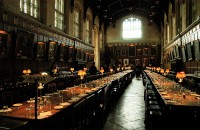
Christ Church
The Great Hall and the staircase leading up to it will be familiar to fans of the Harry Potter films. The picture gallery holds an impressive collection of paintings and drawings, including several by Lewis Carroll. And an excellent student choir performs Evensong daily in Christ Church Cathedral. (Free; 6pm)
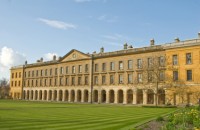
Magdalen College
The college of Oscar Wilde and Cardinal Wolsey features extensive grounds (including a path often walked by C. S. Lewis) and a 15th-century tower.

Merton College
This college’s medieval library is the oldest still in use – many of the volumes are chained to their desks. The quad dates from the 14th century.
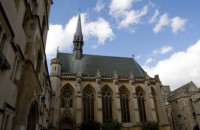
Exeter College
Worth a visit for its exquisite neo-Gothic chapel, rich with stained glass. Several scenes from The Golden Compass were filmed in Exeter College, Christ Church and Radcliffe Square.
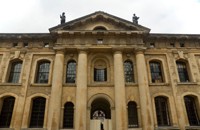
Ashmolean Museum of Art & Archaeology
Beaumont St,
Oxford
OX1 2PH
Tel: +44 (0)1865 278002
Open Tue-Sun and Bank Holiday Mondays 10am-6pm. Closed Dec 24-26.
The oldest museum at Oxford, the present Ashmolean was created in 1908 by combining two ancient Oxford institutions: the University Art Collection and the original Ashmolean Museums. As a result of the merger, the museum houses art and artifacts from across a wide range of cultures, including the world’s best collection of pre-dynastic Egyptian materials, the most important collection of Raphael drawings, and notable curiosities such as Laurence of Arabia’s robes and Guy Fawkes’ lantern. In 2009 the museum reopened after a transformative renovation and expansion, adding a pleasing modernity and flooding the space with light. New Egyptian and Nubian galleries were opened in late 2011.
Boat Race
This rowing competition against Cambridge dates from 1829. The race is held every year in March or early April, along a 4.5 mile stretch of the Thames between Putney and Mortlake.
topBlenheim
Blenheim is the largest house in England and well worth an excursion. This spectacular Baroque Palace was built in the early 18th century as a gift to the First Duke of Marlborough for his victory in battle over the French. The state rooms and formal gardens are exquisite, as are the 2,100 acres of beautiful parkland designed by the famed landscape architect Capability Brown. The palace was also the birthplace of Winston Churchill, and features a special exhibition centered around the room where he was born.
8 mi. NW of Oxford, near the town of Woodstock, 64 mi. NW of London.
Approx. 1.5 hrs by car from central London.
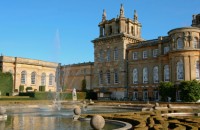
Blenheim Palace
Woodstock
Oxfordshire OX02 1PX
Tel: +44 (0)87 0060 2080 Fax: +44 (0)19 9381 0570
Palace: Open Weds-Sun 10:30am-5:30pm; Closed Dec 14-Feb 14
Formal Gardens: Open Weds-Sun 10:00am-5:30pm; Closed Dec 14-Feb 14
Park: Open daily 9am-dusk; Closed Dec 25
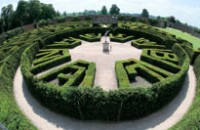
Pleasure Gardens
Open daily 10:30am-dusk
Closed Dec 25
Locomotive operates daily from Apr-Oct at half-hour intervals.
Children will especially enjoy these charming gardens, where they can visit a Butterfly House filled with exotic species, or explore the Marlborough Maze. The gardens can be reached by a miniature train or by car.
topCotswolds
The Cotswold Hills of Gloucestershire were once the center of England’s wool industry. With the rise of the Industrial Revolution, business moved elsewhere, leaving behind a peaceful countryside dotted with thatched-roof stone cottages, gracefully decaying manors and quaint villages. This area is best toured by car, with plenty of time in the schedule for leisurely sightseeing. Exploring by foot is another good option – villages are often no more than three miles apart, connected by excellent walking trails.
85 mi. NW of London. Approx. 2 hrs by car from London.
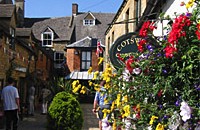
Stow-on-the-Wold
Situated on a hilltop where several roads meet, Stow is an ideal base for exploring the surrounding countryside. The town itself is popular but charming, with a range of pubs, tearooms, and shops housed in 17th and 18th century buildings. At the center of town is the large Market Square, flanked with an ancient cross on one side and the old town stocks on the other.
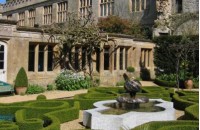
Sudeley Castle
Winchcombe Gloucestershire, GL54 5JD
Tel: +44 (0)12 4260 2308, Visitor Centre: +44 (0)12 4260 4244
Recorded Visitor Information: +44 (0)12 4260 4357
Open daily Apr-Oct 10:30am-5pm
This magnificent castle has a long and rich history, with royal connections dating back a thousand years. The original house was built by King Ethelred (the Unready) around 1000 AD – the current castle, with its turreted stone towers, dates from 1442 and is best known as the home of Henry VIII’s widow, Queen Katherine Parr. Surrounding the castle are some of the most exceptional gardens in England.
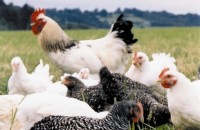
Daylesford Organic Farm
Daylesford
Near Kingham, Gloucestershire, GL56 0YG
Tel: +44 (0)16 0873 1700
Open Mon-Wed 9am-5pm; Thu-Sat 9am-6pm; Sun 10am-4pm
Amazing organic meats, dairy, produce, baked good and extensive range of own products. If you are touring or staying in the Cotswolds, the Farmshop and Cafe are a must. And if you want an indulgent experience, visit the Hay Barn Spa. A new Cookery School offers a full rand of one- and two-day courses.
topStratford-upon-Avon
Stratford is famous as the hometown of William Shakespeare, and most visitors come to see his birthplace and/or take in a play. The town alone is worthwhile, with half-timbered houses, a river filled with canal boats, and a street plan unchanged since the 12th century. Just 8 miles away, touristy but fascinating Warwick Castle is not to be missed.
104 mi. NW of London. Approx. 2.5 hrs by car from London.
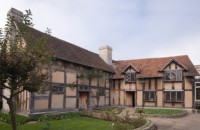
Shakespeare’s Birthplace
Henley Street
Tel: +44 (0) 01789 204 016
Apr-Jun 29, 9am-5pm; June 30-2 Sep 2, 9am-6pm; Sep 3-Nov 4, 9am-5pm, Nov 5-Mar 30, 10am-4pm
Closed Dec 25
The Bard was born in this half-timbered house 1564. The building was later a pub and butcher’s shop, but has been restored with period furnishings. The attached museum is filled with interesting exhibits about Shakespeare’s life and works, including an original folio containing 36 of his 37 plays.
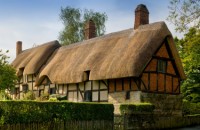
Anne Hathaway’s Cottage
Cottage Lane, Shottery, Stratford-upon-Avon
Tel: +44 (0) 01789 292 100
Apr-Nov 4, 9am - 5pm; Nov 5-Mar 30, 10am-4pm. Closed Dec 25-26
The 12-room farmhouse where Shakespeare’s wife grew up offers an interesting glimpse of life in Elizabethan times. The gardens are especially beautiful.
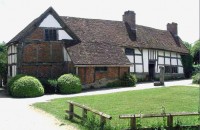
Mary Arden’s Farm
Station Road,
Wilmcote, Stratford-upon-Avon
Tel: +44 (0) 01789 293 455
Mar 19-Nov 4, 10am-5pm. Closed Nov 5-Mar 17
Located about 3 miles from the town center, this folk museum lets visitors experience the daily routine of a working 16th-century farm. Shakespeare’s mother was raised in the historic farmhouse.
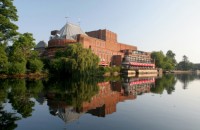
Royal Shakespeare Company
This renowned company performs in Stratford year-round. Currently, the historic Royal Shakespeare Theatre is under renovation (due to be completed in 2010). For now, performances are held in the 1,000-seat Courtyard Theater. It’s best to buy tickets in advance, though standing-room seats are available the day of the performance.
topWarwick
Complete with dungeons and a moat, this is England’s finest medieval castle. Built on the site of a 10th-century rampart, the fortified shell dates from the 14th century; the lavish state rooms and gardens were completed in the 18th century. Visitors can climb the 250 steps up the tower, descend into the torture chamber, see the newly restored Mill and Engine House, or view a waxworks recreation of a royal garden party. The world’s largest trebuchet (a type of medieval catapult) is also here, and is fired twice daily during the summertime.
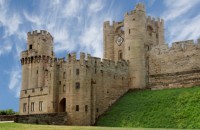
Warwick Castle
Warwickshire, CV34 4QU
Tel: +44 (0)19 2649 5241 Recorded information: +44 (0)871 265 2000 (10p per minute)
customer.information@warwick-castle.com
Daily Sep 3-Jun 1, Jun 11-Jul 20, 10am-5pm; Jun 2-10 and Jul 21-Sep 2, 10am-6pm. Closed Dec 25.
topSalisbury
This town was originally settled in 600 BC, on a hilltop overlooking its current location. During Roman times it was known as Sarum, and grew so prosperous that the entire town was moved to the valley in 1220 AD. Modern Salisbury is best known for its spectacular cathedral, which boasts England’s tallest spire and largest green. The town’s colorful markets, offering crafts, fresh local produce, and French specialties, are the other big draw.
88 mi. SW of London
Approx 2 hrs by car. 1.5 hrs from London by rail from Waterloo Station.

Salisbury Cathedral
Open daily mid-Jun–Aug Mon-Sat 7:15am-7:15pm, Sun 7:15am-7:15pm;
Sept–mid-June 7:15am -6:15pm
Officially known as the Cathedral of St. Mary, this English Gothic masterpiece was completed in 1258. An excellent “Tower Tour” explains how its hollow 404-ft. spire was built. The church is also home to the world’s oldest working clock and one of the original copies of the Magna Carta.
Markets at Market Square
Charter Market: Thursday and Saturdays, 8am-4pm
Retail market selling a variety of goods and produce.
Farmer’s Market: First and third Wednesday of each month, 10am-2pm
Fresh local produce, including fish, meat, fruits & vegetables, game, jams & jellies, breads, cheese, and English wine.
French Market: Takes place three times a year.
Products from Brittany and Normandy, including charcuterie, patisserie, and specialty foods as well as leather goods, clothing, and perfume.
topStonehenge
This famous stone circle has mystified scientists and visitors for centuries. Built some 4000 years ago, Stonehenge is an amazingly accurate celestial calendar, used by ancient civilizations to predict eclipses, solstices and other important days in their ritual cycle. Tourists used to be able to go right up to the stones – today, a fence keeps you at a distance, but it’s still worth a visit if you’re in the area.
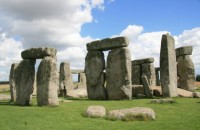
Stonehenge
10 mi. north of Salisbury
Open daily Apr 1-May 31, 9:30am-6pm; Jun 1-Aug 31, 9am-7pm; Sep 1–Oct 15, 9:30am-6pm; Oct 16-Mar 15, 9:30am-4pm; Mar 16-31, 9:30am-6pm.
Hours may be restricted during summer solstice
Closed Dec 24, Dec 25
topAvebury
Older, less touristy and more accessible than Stonehenge (though not nearly as famous), Avebury is the largest known stone circle in the world. Though archaeologists believe it was used for a span of some 2,300 years, its purpose remains a mystery. The stones, ranging from nine to over 20 feet high, form a ring 1,396 feet in diameter. During the 14th century, many of the stones were removed by Christian authorities in an attempt to eradicate all trace of pagan culture.

Avebury
36 mi. north of Salisbury; 27 mi. east of Bath; 91 mi. west of London
Tel: +44 (0)1672 539 250
Open during daylight hours - facilities may not be available during Summer solstice.
Alexander Keiller Archaeology Museum:
Open daily Apr–Oct, 10am-6pm; Nov–Mar 10am-4pm
topWinchester
This historic city was the capital of England during the 9th century (chosen by the Saxon ruler King Arthur the Great), and it remained a royal residence for centuries after. Winchester is known for its ancient cathedral, its impressive Great Hall, and Winchester College, the oldest continually running school in the country. Lovers of food will enjoy the farmer’s market (the UK’s largest). Lovers of literature will want to visit the grave of Jane Austen. And lovers of cricket should make a pilgrimage to the nearby village of Hambledon, where the game was raised “from a sport to an art”.
69 mi. from London; approx. 1.75 hrs by car. M25 to M3, Junctions 9 or 11 off the M3. 55 min. by rail from Waterloo Station.
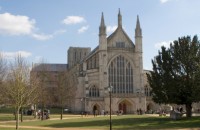
Winchester Cathedral
Open daily 8:30am-6pm (5:30pm Sunday)
Guided tours Mon-Sat, 10am-3pm
Restricted access during services
Begun in 1079, the cathedral was remodeled in Gothic style in the 14th century and features the longest nave in Europe. Its library dates from 1150 and houses the gorgeously illuminated Winchester Bible. Beloved author Jane Austen is buried in the cathedral nave. In the early 1900s, diver William Walker saved the cathedral from collapse by diving into the groundwater and shoring up rotten timbers and masonry. A bronze statue commemorates his achievements. The Cathedral Close contains a number of historic buildings – the Deanery was the birthplace of Prince Arthur, older brother of King Henry VIII; Pilgrims’ Hall is the oldest hammer-beamed building in England.
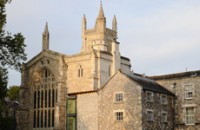
Winchester College
St. Cross Road
Tel: +44 (0)19 6262 1209
Tours daily, 9:30 am, 11:00 am, 2:15 pm & 3:30 pm
Founded in 1382, this college has been educating students continuously for over 600 years. Many of its medieval buildings are still used for their original purposes. Guided tours concentrate on the 14th century chapel, the original Scholar’s dining room, and the medieval cloister.
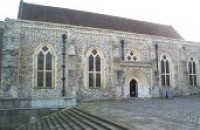
Winchester Castle
High Street
Tel: +44 (0)196 284 6476
Open daily 10am to 5pm, closed Dec 25-26
All that remains of this Norman castle is its Great Hall, the first and finest of England’s 13th century halls. Within the hall hangs a famous Round Table inscribed with the names of King Arthur’s knights. Once thought to be the original Round Table, historians now know it dates from the 13th century, well past Arthur’s time. Just outside the Great Hall is Queen Eleanor’s Garden, an accurate recreation of a medieval herbarium.
Farmer’s Market
Middle Brook Street
9am-2pm, second and last Sunday of the month
Britain’s largest farmer’s market features over 90 local producers. All produce sold must have been grown, reared, caught, brewed, pickled, baked, or processed within Hampshire (or no more than 10 miles beyond).
topBath
200 years ago, Bath was the most fashionable town in England. Aristocrats flocked here to visit the spa resort and attend balls and concerts. It was popular in Roman times as well, due to its famed mineral hot springs. During Saxon times, it was the religious center of England. But it wasn’t until the 18th century that Bath really flourished – 90 percent of its historic buildings date from this period. Built almost entirely of creamy limestone, the city is a marvel of elegant Georgian architecture and gracefully proportioned streets. Jane Austen lived here for five years – her novel Persuasion is set largely in Bath. The artist Thomas Gainsborough rose to fame during his 16 years here. Today’s visitors will be charmed by Bath’s beauty, fine entertainment, and colorful history.
114 mi. west of London. Approx. 2.5 hrs by car; M4 to Junction 18, then A46. 1.5 hrs by rail from Paddington Station.
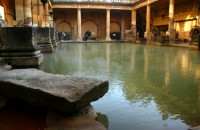
Roman Baths
Abbey Church Yard
Tel: +44 (0)1225 477 785
Jan-Feb and Nov-Dec 9:30am-4:30pm; Mar-June and Sep-Oct 9am-5pm; July-Aug 9am–9pm. Closed December 25-26.
Even before the Romans arrived, this area was known for its 116°F hot springs, the only hot springs in Britain. The Romans called the town Aquae Sulis and built a magnificent temple and bathing complex here in the 1st century AD. The ancient baths are now surrounded by a fine museum, where visitors can tour the well-preserved ruins.
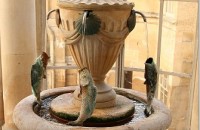
Pump Room
Daily 9:30am-5pm
Tel: +44 (0)1225 444 477
The fame of Bath’s mineral spring declined in the middle ages, until the barren Queen Mary visited in 1687 – and bore a child 10 months later. Word of the water’s healing power spread. In the 18th century, a lavish Georgian hall was built, where the cream of society could see and be seen taking the water. Today the Pump Room is an elegant place to enjoy coffee, lunch, afternoon tea, and of course, try the water for yourself. (Warning: it tastes terrible.)
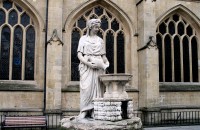
Bath Abbey
Apr–Oct Mon-Sat 9am-6pm, Sun 1pm-2:30pm and 4:30pm-5:30pm;
Nov – Mar Mon-Sat 9am-4:30pm, Sun 1pm-2:30pm and 4:30pm-5:30pm
Vaults Museum: Mon-Sat 10am-3:30pm year-round
The first church was built on this site in 757, when Bath was an important religious center. King Edgar was crowned there in 973. That church was torn down by the Normans, and a massive cathedral was built in its place. Too large to be maintained, it was soon in ruins. The current cathedral was built in the 14th and 16th centuries and is a fine example of late English Gothic. The Heritage Vaults museum tells the history of Christianity in Bath.
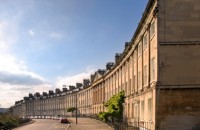
Royal Crescent
Designed by John Woods the Younger, this splendid, curving row of Palladian townhomes is the jewel in Bath’s architectural crown. The yard features a “ha-ha fence,” a trench invisible to viewers at the windows, intended to keep out sheep and other undesireables.
Number One Royal Crescent
Tel: +44 (0)1225 428 126
Open Tue-Sun 10:30am-5pm. Closed Mon.
The first of the Crescent’s houses to be built is now an excellent museum, authentically and lavishly furnished in 18th-century style. Volunteers stationed throughout the house offer fascinating insights and details about Georgian life.
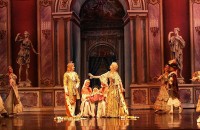
Theatre Royal
Sawclose
Main House/Ustinov: +44 (0)1225 448 844
The Egg:
+44 (0)1225 823 409
This lovely, newly-restored theater features three venues (the Main House, Ustinov and the egg theatre for children) showing a variety of programs. It’s a great opportunity to see London-quality performances at a discounted price (many of the West End theaters do their dress-rehearsal runs here).
Fashion Museum
Assembly Rooms, Bennett Street
Tel: +44 (0)12 2547 7789
Open daily Jan-Feb & Nov–Dec 10:30am-4pm; Mar-Oct 10:30am-5pm
Closed Dec 25-26
With over 400 years of fashion on display – from 16th century embroidered gloves to 20th-century evening gowns – this collection of contemporary and historical dress is truly world-class. Especially fun for kids as well as adults is the “Corsets and Crinolines” display, where visitors can try on reproduction garments.
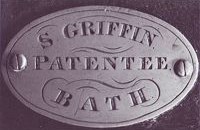
Museum of Bath at Work
Camden Works, Julian Road, Bath
Tel: +44 (0)1225 318 348
Open 10:30am-5pm daily Apr–Oct; weekends only Nov–Mar. Closed Dec.
Considered one of England’s best small museums, this quirky collection traces Bath’s commercial and industrial heritage over the last 2000 years. Interactive displays and demonstrations bring it all to life. The centerpiece of the museum is the reconstructed engineer’s shop and soft drinks factory of Victorian businessman J. B. Bowler.
Walking Tours
Year-round Sun-Fri 10:30am and 2pm; Sat 10:30 only. Additional tours May-Sep, Tue and Thu, 7pm.
Tours leave from in front of the Pump Room
The Mayor’s Corps of Honorary Guides offers wonderfully entertaining walking tours led by well-informed volunteers. If you aren’t booking a private tour, these free two-hour tours are highly recommended – they’ll help you fully appreciate the social nuances of Bath’s Georgian past.
Copyright 2013 MyLittleSwans, LLC. All rights reserved. My Little Swans, the logo and Share a world of experience are registered Trademarks of MyLittleSwans, LLC. Use of this site constitutes acceptance of our Terms of Use and Privacy Policy.

















